高中英语教学案例《倒装句语法》教学设计
- 格式:doc
- 大小:39.00 KB
- 文档页数:9
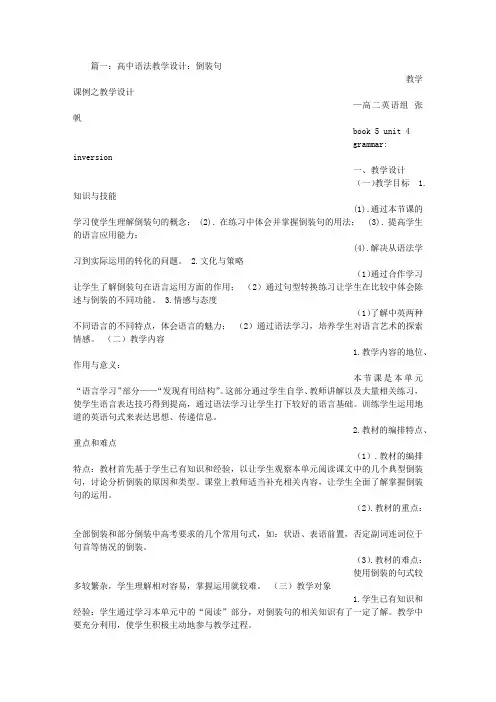
篇一:高中语法教学设计:倒装句教学课例之教学设计—高二英语组张帆book 5 unit 4grammar: inversion一、教学设计(一)教学目标 1.知识与技能(1).通过本节课的学习使学生理解倒装句的概念; (2).在练习中体会并掌握倒装句的用法; (3).提高学生的语言应用能力;(4).解决从语法学习到实际运用的转化的问题。
2.文化与策略(1)通过合作学习让学生了解倒装句在语言运用方面的作用;(2)通过句型转换练习让学生在比较中体会陈述与倒装的不同功能。
3.情感与态度(1)了解中英两种不同语言的不同特点,体会语言的魅力;(2)通过语法学习,培养学生对语言艺术的探索情感。
(二)教学内容1.教学内容的地位、作用与意义:本节课是本单元“语言学习”部分——“发现有用结构”。
这部分通过学生自学、教师讲解以及大量相关练习,使学生语言表达技巧得到提高,通过语法学习让学生打下较好的语言基础。
训练学生运用地道的英语句式来表达思想、传递信息。
2.教材的编排特点、重点和难点(1).教材的编排特点:教材首先基于学生已有知识和经验,以让学生观察本单元阅读课文中的几个典型倒装句,讨论分析倒装的原因和类型。
课堂上教师适当补充相关内容,让学生全面了解掌握倒装句的运用。
(2).教材的重点:全部倒装和部分倒装中高考要求的几个常用句式,如:状语、表语前置,否定副词连词位于句首等情况的倒装。
(3).教材的难点:使用倒装的句式较多较繁杂,学生理解相对容易,掌握运用就较难。
(三)教学对象1.学生已有知识和经验:学生通过学习本单元中的“阅读”部分,对倒装句的相关知识有了一定了解。
教学中要充分利用,使学生积极主动地参与教学过程。
2.学生学习方法和技巧:在现实语法学习过程中,很多学生过分把注意力放在语法规则上面,而不注重语言运用能力的培养。
在教学中,通过句型转换、改错等练习的训练让学生在实际中运用语法规则,而不是死记硬背语法的条条框框。
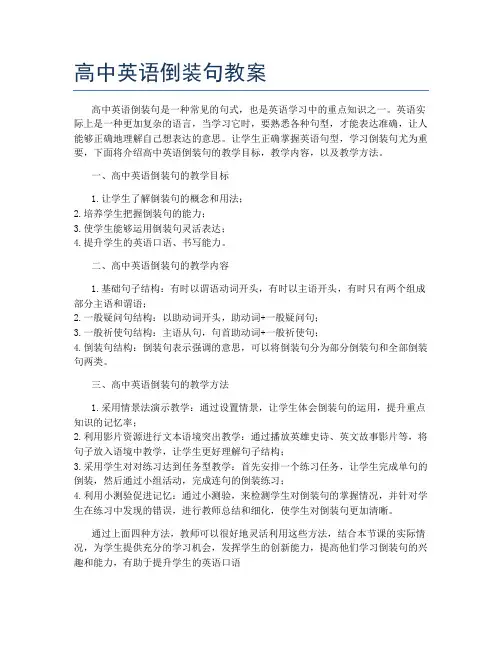
高中英语倒装句教案高中英语倒装句是一种常见的句式,也是英语学习中的重点知识之一。
英语实际上是一种更加复杂的语言,当学习它时,要熟悉各种句型,才能表达准确,让人能够正确地理解自己想表达的意思。
让学生正确掌握英语句型,学习倒装句尤为重要,下面将介绍高中英语倒装句的教学目标,教学内容,以及教学方法。
一、高中英语倒装句的教学目标1.让学生了解倒装句的概念和用法;2.培养学生把握倒装句的能力;3.使学生能够运用倒装句灵活表达;4.提升学生的英语口语、书写能力。
二、高中英语倒装句的教学内容1.基础句子结构:有时以谓语动词开头,有时以主语开头,有时只有两个组成部分主语和谓语;2.一般疑问句结构:以助动词开头,助动词+一般疑问句;3.一般祈使句结构:主语从句,句首助动词+一般祈使句;4.倒装句结构:倒装句表示强调的意思,可以将倒装句分为部分倒装句和全部倒装句两类。
三、高中英语倒装句的教学方法1.采用情景法演示教学:通过设置情景,让学生体会倒装句的运用,提升重点知识的记忆率;2.利用影片资源进行文本语境突出教学:通过播放英雄史诗、英文故事影片等,将句子放入语境中教学,让学生更好理解句子结构;3.采用学生对对练习达到任务型教学:首先安排一个练习任务,让学生完成单句的倒装,然后通过小组活动,完成连句的倒装练习;4.利用小测验促进记忆:通过小测验,来检测学生对倒装句的掌握情况,并针对学生在练习中发现的错误,进行教师总结和细化,使学生对倒装句更加清晰。
通过上面四种方法,教师可以很好地灵活利用这些方法,结合本节课的实际情况,为学生提供充分的学习机会,发挥学生的创新能力,提高他们学习倒装句的兴趣和能力,有助于提升学生的英语口语。
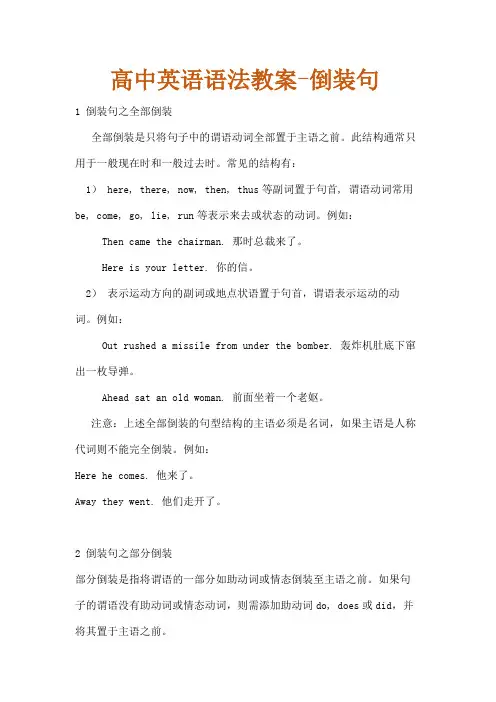
高中英语语法教案-倒装句1 倒装句之全部倒装全部倒装是只将句子中的谓语动词全部置于主语之前。
此结构通常只用于一般现在时和一般过去时。
常见的结构有:1) here, there, now, then, thus等副词置于句首, 谓语动词常用be, come, go, lie, run等表示来去或状态的动词。
例如: Then came the chairman. 那时总裁来了。
Here is your letter. 你的信。
2)表示运动方向的副词或地点状语置于句首,谓语表示运动的动词。
例如:Out rushed a missile from under the bomber. 轰炸机肚底下窜出一枚导弹。
Ahead sat an old woman. 前面坐着一个老妪。
注意:上述全部倒装的句型结构的主语必须是名词,如果主语是人称代词则不能完全倒装。
例如:Here he comes. 他来了。
Away they went. 他们走开了。
2 倒装句之部分倒装部分倒装是指将谓语的一部分如助动词或情态倒装至主语之前。
如果句子的谓语没有助动词或情态动词,则需添加助动词do, does或did,并将其置于主语之前。
1. 句首为否定或半否定的词语,如no, not, never, seldom, little, hardly, at no time, in no way, not until… 等。
例如: Never have I seen such a performance. 从未见过如此糟糕的表演。
Nowhere will you find the answer to this question. 无论如何你不会找到这个问题的答案的。
Not until the child fell asleep did the mother leave the room. 母亲一直到孩子入睡后离开房间。
当Not until引出主从复合句,主句倒装,从句不倒装。
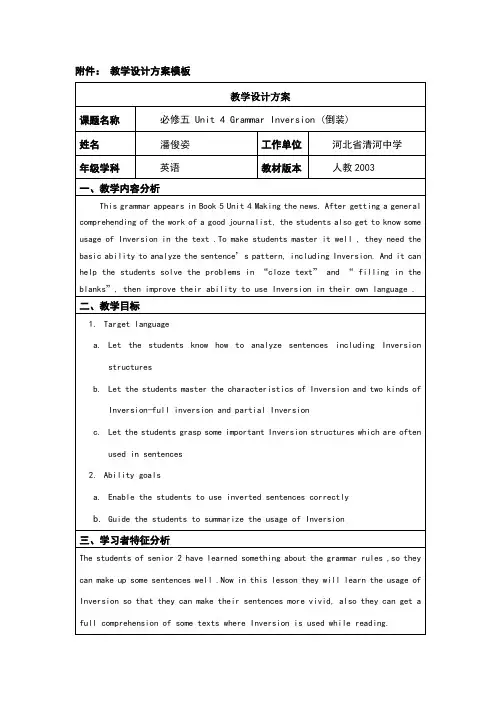
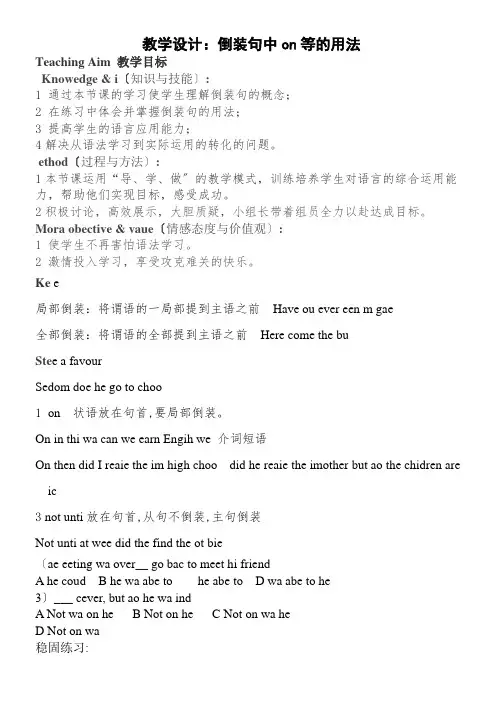
教学设计:倒装句中on等的用法Teaching Aim 教学目标Knowedge & i〔知识与技能〕:1 通过本节课的学习使学生理解倒装句的概念;2 在练习中体会并掌握倒装句的用法;3 提高学生的语言应用能力;4解决从语法学习到实际运用的转化的问题。
ethod〔过程与方法〕:1本节课运用“导、学、做〞的教学模式,训练培养学生对语言的综合运用能力,帮助他们实现目标,感受成功。
2积极讨论,高效展示,大胆质疑,小组长带着组员全力以赴达成目标。
Mora obective & vaue〔情感态度与价值观〕:1 使学生不再害怕语法学习。
2 激情投入学习,享受攻克难关的快乐。
Ke e局部倒装:将谓语的一局部提到主语之前Have ou ever een m gae全部倒装:将谓语的全部提到主语之前Here come the buSte e a favourSedom doe he go to choo1 on状语放在句首,要局部倒装。
On in thi wa can we earn Engih we介词短语On then did I reaie the im high choo did he reaie the imother but ao the chidren are ic3 not unti放在句首,从句不倒装,主句倒装Not unti at wee did the find the ot bie〔ae eeting wa over__ go bac to meet hi friendA he coudB he wa abe to he abe to D wa abe to he3〕___ cever, but ao he wa indA Not wa on heB Not on heC Not on wa heD Not on wa稳固练习:1 Not unti I came home at night________to bedA.Mum did go B.did Mum go C.went MumD.Mum went2 Not unti I began to wor ____ reaie how much time I had watedA didn't IB did IC I didn'tD I〔Puroe:走进高考,考查学生学以致用的能力〕Ste 4: Concuionon ,not unti 前不倒后倒。
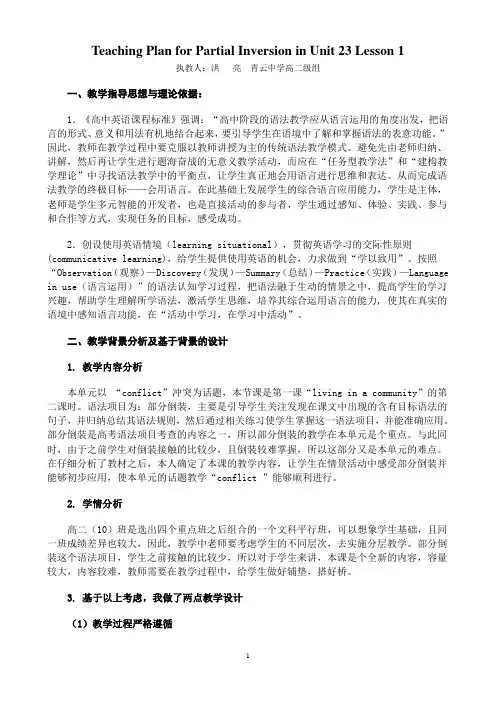
Teaching Plan for Partial Inversion in Unit 23 Lesson 1执教人:洪亮青云中学高二级组一、教学指导思想与理论依据:1.《高中英语课程标准》强调:“高中阶段的语法教学应从语言运用的角度出发,把语言的形式、意义和用法有机地结合起来,要引导学生在语境中了解和掌握语法的表意功能。
”因此,教师在教学过程中要克服以教师讲授为主的传统语法教学模式。
避免先由老师归纳、讲解,然后再让学生进行题海奋战的无意义教学活动,而应在“任务型教学法”和“建构教学理论”中寻找语法教学中的平衡点,让学生真正地会用语言进行思维和表达。
从而完成语法教学的终极目标——会用语言。
在此基础上发展学生的综合语言应用能力,学生是主体,老师是学生多元智能的开发者,也是直接活动的参与者,学生通过感知、体验、实践、参与和合作等方式,实现任务的目标,感受成功。
2.创设使用英语情境(learning situational),贯彻英语学习的交际性原则(communicative learning),给学生提供使用英语的机会,力求做到“学以致用”。
按照“Observation(观察)—Discovery(发现)—Summary(总结)—Practice(实践)—Language in use(语言运用)”的语法认知学习过程,把语法融于生动的情景之中,提高学生的学习兴趣,帮助学生理解所学语法,激活学生思维,培养其综合运用语言的能力, 使其在真实的语境中感知语言功能,在“活动中学习,在学习中活动”。
二、教学背景分析及基于背景的设计1. 教学内容分析本单元以“conflict”冲突为话题,本节课是第一课“living in a community”的第二课时。
语法项目为:部分倒装,主要是引导学生关注发现在课文中出现的含有目标语法的句子,并归纳总结其语法规则,然后通过相关练习使学生掌握这一语法项目,并能准确应用。
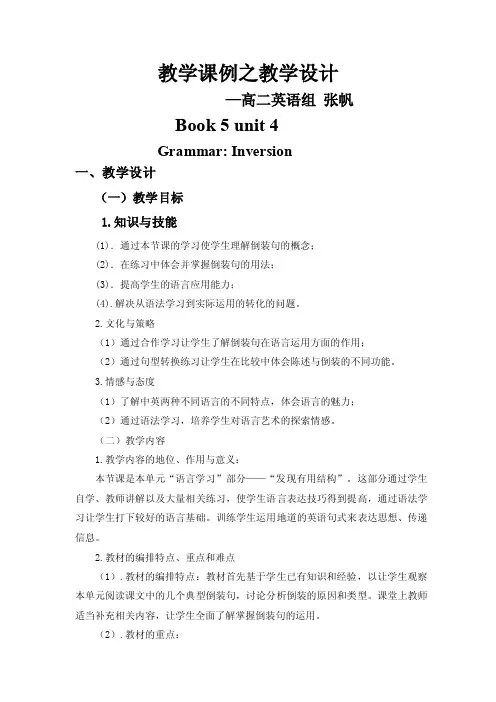
教学课例之教学设计—高二英语组张帆Book 5 unit 4Grammar: Inversion一、教学设计(一)教学目标1.知识与技能(1).通过本节课的学习使学生理解倒装句的概念;(2).在练习中体会并掌握倒装句的用法;(3).提高学生的语言应用能力;(4).解决从语法学习到实际运用的转化的问题。
2.文化与策略(1)通过合作学习让学生了解倒装句在语言运用方面的作用;(2)通过句型转换练习让学生在比较中体会陈述与倒装的不同功能。
3.情感与态度(1)了解中英两种不同语言的不同特点,体会语言的魅力;(2)通过语法学习,培养学生对语言艺术的探索情感。
(二)教学内容1.教学内容的地位、作用与意义:本节课是本单元“语言学习”部分——“发现有用结构”。
这部分通过学生自学、教师讲解以及大量相关练习,使学生语言表达技巧得到提高,通过语法学习让学生打下较好的语言基础。
训练学生运用地道的英语句式来表达思想、传递信息。
2.教材的编排特点、重点和难点(1).教材的编排特点:教材首先基于学生已有知识和经验,以让学生观察本单元阅读课文中的几个典型倒装句,讨论分析倒装的原因和类型。
课堂上教师适当补充相关内容,让学生全面了解掌握倒装句的运用。
(2).教材的重点:全部倒装和部分倒装中高考要求的几个常用句式,如:状语、表语前置,否定副词连词位于句首等情况的倒装。
(3).教材的难点:使用倒装的句式较多较繁杂,学生理解相对容易,掌握运用就较难。
(三)教学对象1.学生已有知识和经验:学生通过学习本单元中的“阅读”部分,对倒装句的相关知识有了一定了解。
教学中要充分利用,使学生积极主动地参与教学过程。
2.学生学习方法和技巧:在现实语法学习过程中,很多学生过分把注意力放在语法规则上面,而不注重语言运用能力的培养。
在教学中,通过句型转换、改错等练习的训练让学生在实际中运用语法规则,而不是死记硬背语法的条条框框。
3.通过课后的写作训练,让学生尽量把所学的倒装句式运用到作文中去。
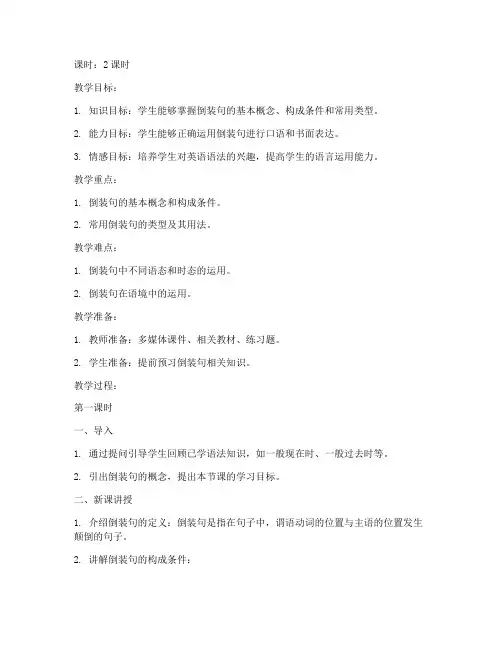
课时:2课时教学目标:1. 知识目标:学生能够掌握倒装句的基本概念、构成条件和常用类型。
2. 能力目标:学生能够正确运用倒装句进行口语和书面表达。
3. 情感目标:培养学生对英语语法的兴趣,提高学生的语言运用能力。
教学重点:1. 倒装句的基本概念和构成条件。
2. 常用倒装句的类型及其用法。
教学难点:1. 倒装句中不同语态和时态的运用。
2. 倒装句在语境中的运用。
教学准备:1. 教师准备:多媒体课件、相关教材、练习题。
2. 学生准备:提前预习倒装句相关知识。
教学过程:第一课时一、导入1. 通过提问引导学生回顾已学语法知识,如一般现在时、一般过去时等。
2. 引出倒装句的概念,提出本节课的学习目标。
二、新课讲授1. 介绍倒装句的定义:倒装句是指在句子中,谓语动词的位置与主语的位置发生颠倒的句子。
2. 讲解倒装句的构成条件:a. 句首有否定副词或否定词组,如never, hardly, seldom, little, not only...but also...等。
b. 句首有疑问词,如who, what, when, where, why, how等。
c. 句首有表示地点的介词短语,如in the front, on the top等。
3. 举例说明倒装句的类型及其用法:a. 疑问句倒装:如“Where did you go yesterday?”b. 否定句倒装:如“Never have I seen such a beautiful scene before.”c. 条件句倒装:如“If I had known, I would have helped you.”d. 让步状语从句倒装:如“Though he is poor, he is honest.”三、课堂练习1. 完成教材中的练习题,巩固所学知识。
2. 教师讲解练习题,纠正学生错误。
四、总结1. 总结本节课所学内容,强调倒装句的基本概念、构成条件和常用类型。
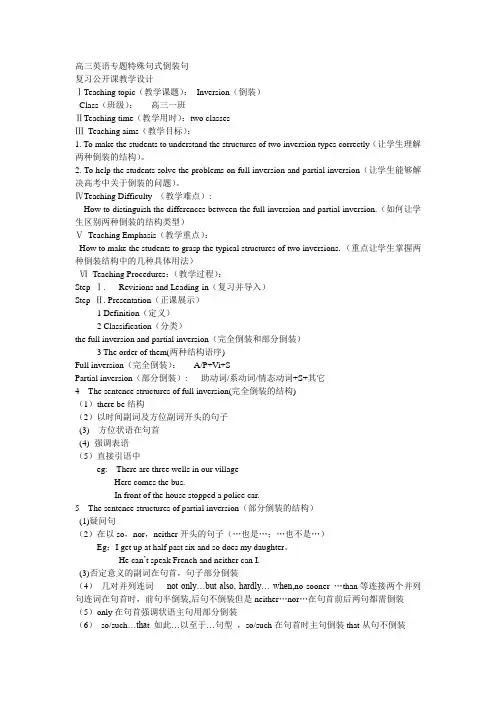
高三英语专题特殊句式倒装句复习公开课教学设计ⅠTeaching topic(教学课题):Inversion(倒装)Class(班级):高三一班ⅡTeaching time(教学用时):two classesⅢTeaching aims(教学目标):1. To make the students to understand the structures of two inversion types correctly(让学生理解两种倒装的结构)。
2. To help the students solve the problems on full inversion and partial inversion(让学生能够解决高考中关于倒装的问题)。
ⅣTeaching Difficulty (教学难点):How to distinguish the differences between the full inversion and partial inversion.(如何让学生区别两种倒装的结构类型)ⅤTeaching Emphasis(教学重点):How to make the students to grasp the typical structures of two inversions. (重点让学生掌握两种倒装结构中的几种具体用法)ⅥTeaching Procedures:(教学过程):Step Ⅰ. Revisions and Leading-in(复习并导入)Step Ⅱ. Presentation(正课展示)1 Definition(定义)2 Classification(分类)the full inversion and partial inversion(完全倒装和部分倒装)3 The order of them(两种结构语序)Full inversion(完全倒装):A/P+Vi+SPartial inversion(部分倒装): 助动词/系动词/情态动词+S+其它4 The sentence structures of full inversion(完全倒装的结构)(1)there be结构(2)以时间副词及方位副词开头的句子(3) 方位状语在句首(4) 强调表语(5)直接引语中eg: There are three wells in our villageHere comes the bus.In front of the house stopped a police car.5 The sentence structures of partial inversion(部分倒装的结构)(1)疑问句(2)在以so,nor,neither开头的句子(…也是…;…也不是…)Eg:I get up at half past six and so does my daughter。
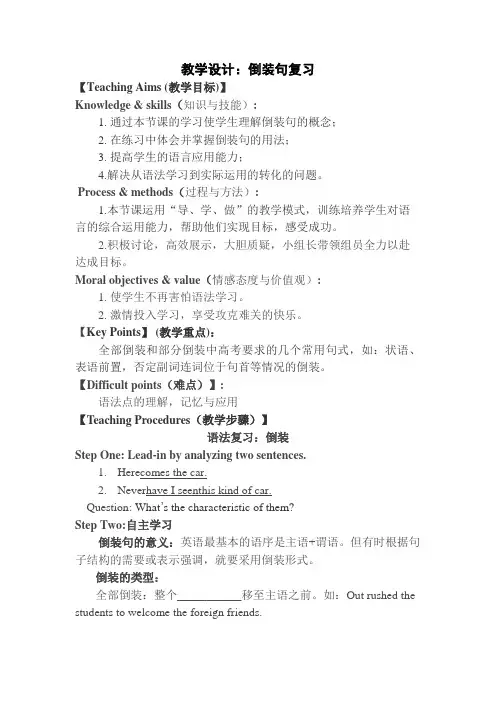
教学设计:倒装句复习【Teaching Aims (教学目标)】Knowledge & skills(知识与技能):1. 通过本节课的学习使学生理解倒装句的概念;2. 在练习中体会并掌握倒装句的用法;3. 提高学生的语言应用能力;4.解决从语法学习到实际运用的转化的问题。
Process & methods(过程与方法):1.本节课运用“导、学、做”的教学模式,训练培养学生对语言的综合运用能力,帮助他们实现目标,感受成功。
2.积极讨论,高效展示,大胆质疑,小组长带领组员全力以赴达成目标。
Moral objectives & value(情感态度与价值观):1. 使学生不再害怕语法学习。
2. 激情投入学习,享受攻克难关的快乐。
【Key Points】 (教学重点):全部倒装和部分倒装中高考要求的几个常用句式,如:状语、表语前置,否定副词连词位于句首等情况的倒装。
【Difficult points(难点)】:语法点的理解,记忆与应用【Teaching Procedures(教学步骤)】语法复习:倒装Step One: Lead-in by analyzing two sentences.1.Herecomes the car.2.Neverhave I seenthis kind of car.Question: What’s the characteristic of them?Step Two:自主学习倒装句的意义:英语最基本的语序是主语+谓语。
但有时根据句子结构的需要或表示强调,就要采用倒装形式。
倒装的类型:全部倒装:整个___________移至主语之前。
如:Out rushed the students to welcome the foreign friends.部分倒装:只把_______________________________________放在主语之前。

教学过程一、复习预习1、Which、who、whom、whose、that、as等关系代词引导的定语从句;2、When、where、why等关系副词引导的定语从句3、如何决定用关系代词还是关系副词二、知识讲解与例题精析主语和谓语是句子的核心,它们之间有两种语序:一是主语在谓语之前称为自然语序(Natural Order);二是主语在谓语之后则称为倒装语序(Inverted Order)。
而倒装语序中又有完全倒装(Full Inversion)和部分倒装(Partial Inversion)完全倒装(Full Inversion):又称"全部倒装",是指将句子中的谓语动词全部置于主语之前。
此结构通常只用与一般现在时和一般过去时。
部分倒装(Partial Inversion):指将谓语的一部分如助动词或情态动词倒装至主语之前,而谓语动词无变化。
如果句中的谓语没有助动词或情态动词,则需添加助动词do, does或did,并将其置于主语之前。
英语句子的倒装一是由于语法结构的需要而进行的倒装,二是由于修辞的需要而进行的倒装。
前一种情况,倒装是必须的,否则就会出现语法错误;后一种情况,倒装是选择性的,倒装与否只会产生表达效果上的差异。
语义解析一、表示强调:倒装句最突出、最常见的修辞效果就是强调,其表现形式如下:1.only +状语或状语从句置于句首,句子用部分倒装。
例子:Only in this way can you solve this problem.只有用这种方法,你才可以解决这个问题。
Only after he had spoken out the word did he realize he had made a big mistake.只有当他已经说出那个字后才意识到自己犯了个大错误。
2. hardly, in no way, little, scarcely, seldom, never, no more, no longer, not, not only, no sooner, not only … (but also),not until…等具有否定意义的词或词组位于句首,句子用部分倒装。
从例句到实战:高三英语倒装句教案高三英语倒装句教案作为英语的一个重要语法形式,倒装句在高中英语中占据着重要的地位。
尤其是在高三阶段,倒装句的掌握程度直接关系到英语的高分表现。
然而,倒装句在高三阶段学习起来也相对有一定的难度,需要学生们通过例句的积累来加深对倒装句的理解和应用。
本篇文章将介绍一份高三英语倒装句教案,帮助学生们从例句到实战去掌握倒装句。
一、教学目标1.了解倒装句的定义及语法结构。
2.熟悉倒装句的种类及应用场景。
3.掌握如何识别及构造倒装句。
4.提高学生的语法意识及语言表达能力。
二、教学重点1.熟悉倒装句的种类及语法结构。
2.掌握倒装句的应用场景及构造方法。
三、教学难点1.倒装句的种类及应用。
2.学生如何理解及运用倒装句。
四、教学方法1.案例分析法。
2.相互讨论法。
3.答疑解惑法。
五、教学过程1.导入环节老师介绍倒装句的基本概念,让学生们简单了解到倒装句的定义及其语法结构。
2.初步了解倒装句的种类及应用场景老师通过示范案例来帮助学生了解倒装句的种类及应用场景。
学生们在这个过程中可以对不同种类的倒装句进行初步的辨认和分类。
3.完整掌握各种类型倒装句的应用及构造方法老师继续深入教学,通过对各种类型倒装句进行分析,帮助学生掌握逐步深入的倒装用法。
每一种倒装句的构造方法及应用场景都进行详细解释,并让学生通过课前准备及课堂练习来对所学到的倒装句进行巩固。
4.倒装句的运用在掌握各种类型倒装句的应用及构造方法之后,老师进一步通过教学案例来帮助学生巩固所学内容。
让学生们结合实际情况,进行倒装句的构造并进行实践,让学生更好的掌握倒装句的运用。
5.总结复习在教学过程中,老师需要随时总结和复习所学内容,让学生在课程结束后能够全面了解倒装句,并能够熟练运用倒装句。
六、教学总结在高三英语倒装句教学中,教师需要采用多种教学方法,尤其是通过案例分析与相互讨论来帮助学生更好的掌握所学内容。
同时在教学过程中,也需要注重对学生问题的解答,确保学生能够顺利的掌握倒装句的相关知识和技巧。
人教版高三英语(复习课)
课题:必修5 Unit 4 Grammar Inversion
一、教材分析
本节课是对人教版高二英语必修5 Unit4语法内容Inversion(倒装句)的复习。
倒装句是高考的热点。
近年来命题者加大了对句子结构和知识面的考查,同时注重考查知识之间的交叉和语法知识的力度。
这就要求我们在平时的复习和备考中注意总结,全面把握,深入研究。
倒装是英语中一个重要的修辞手段。
倒装句的使用丰富了我们的语言表达,了解并掌握倒装句各种句式的用法 , 不仅会提高我们对英语语言的欣赏能力 , 对英语表达能力的提高也将大有裨益。
因此,写作中适当用一些倒装句式定会使文章表达更生动、有力。
二、学情分析
高三学生在高二时已经学过倒装句,已具备一定的词汇量、语法知识和阅读技巧。
但由于没有系统地归纳过倒装句的用法,对该用法模糊不清,影响了对文章中含有倒装的句子的理解。
三、教学目标:
1.To sum up the usage of inversion through the students’ discovery.
2.Enable the students to understand the sentences written in inversion.
3.Enable the students to use inverted sentences correctly.
四、教学重点和难点:
1. Enable the students to use inversion properly.
2. How to use inversion in real situations.。
高中英语词法专题倒装句精品教案一、教学目标•了解倒装句在句子结构中的作用和表达方式。
•掌握倒装句的基本用法。
•能够灵活运用倒装句来提高语言表达能力。
二、教学重点•理解倒装句的概念和作用。
•掌握倒装句的常见形式和运用场景。
三、教学准备•教师准备教学课件和教材。
•学生准备纸笔,做笔记。
四、教学过程1. 引入(教师利用幻灯片或黑板白板进行教学)倒装句是英语语法中的一种重要结构,它的使用能够提高句子的表达效果,使语言更加生动有力。
在句子中常常采用主谓倒装和完全倒装两种形式。
那么,我们首先来了解一下什么是倒装句,以及它在句子中的作用。
2. 知识讲解1.主谓倒装主谓倒装是指将句子中的主语和谓语的位置进行调换,从而使句子结构颠倒的一种表达方式。
主谓倒装常出现在以下情况:•在句首表示强调或突出某一部分内容,常用于频度副词、时间状语等的引导下。
例如:–Never have I seen such a beautiful sunset.–Not only does he study hard, but he also plays basketball well.•在虚拟条件句和否定词连用时,常用于if引导的条件句中。
例如:–Had he known the truth, he wouldn’t have made that mistake.–Should you have any questions, please feel free to ask.2.完全倒装完全倒装是指将整个谓语放在主语之前的一种倒装结构。
完全倒装常出现在以下情况:•在以副词here, there, out, up等开头的句子中。
例如:–Here comes the bus.–Down fell the rain.•在以“so + 形容词/副词 + 主语”结构的句子中。
例如:–So fast did he run that he won the race.3.判断倒装句如何判断一个句子是否为倒装句呢?主谓倒装和完全倒装句的主要特点是谓语放在主语之前,除此之外还要注意以下几点:•主谓倒装句中,主语和谓语之间是否有不可分割的词,如never, seldom, by no means等。
高中英语《语法-倒装句》教学设计第一篇:高中英语《语法-倒装句》教学设计Inversions Teaching PlanI Teaching Aims Knowledge aims1.Students can recognize the inversion patterns, and get to know of its grammar meaning of emphasizing.2.Students can identify different situations where inversions need to be adopted.Ability aims 1.Students will be able to use inversions in their own spoken English to make their ideas much clearer.2.Students will be able to write their own articles with inversions to make their work more diversified in expressions.Emotional aim 1.Students will see group work means efficiency after the brainstorm activity.2.Students will get satisfaction by their practice to apply the new knowledge and form a stronger interest in English learning.II Teaching Key &Difficult Points Key point:situations, such as expressions with not, negative adverbs, here and there, and so on.Difficult point: The difficult point is to use inversions in their own speeches and writings.III Teaching procedures: Step 1: Warming up Set up a competition among them and ask them working in groups of 4 to write down all the negative adverbs and phrases that they can ever think of in two minutes.They should come out of different answers as many as possible.Then check their answers(never,seldom,few,little, barely,hardly,scarcely,rarely, nowhere, by no means, under no circumstances, in no way, at no time, in no case, in vain, not until)and decide which group is doing the best job and give compliments accordingly.(Justification: Brain storming is the best way to get the students into thinking by themselves, as they aresupposed to learn actively other than passively.And this also serves as a good foundation for the further study of inversions.)Step 2 : Presentation Ask them to observe the sentences showing on the PPT and to tell the class what can they find is same between these sentences.Never have we witnessed such cruel behaviour by one child to another.Seldom does one hear a politician say ‘sorry’.Under no circumstances shall I betray my country.Then make a conclusion that in formal styles, when we use an adverb or a phrase with negative meaning in front position for emphasis, we invert the subject and auxiliary/modal verb.Show them another two sentences, and ask them to tell the difference between them and the sentences showed on the last PPT.Here comes the bus!I opened the door and there stood Michael, all covered in mud.Then make a conclusion that inversion can also happen after here, and after there when it is as an adverb of place.After here and there, we can use a main verb without an auxiliary verb or modal verb.(Justification: Leading the students to find out the rules by giving related examples makes sure that the students keep focusing on the grammar class, which will make the class more productive.)Step 3: Practice Ask them to finish the exercise I have prepared for them.Then they will be asked to deal with a task which is a little bit harder----to rewrite the sentences using the inversions.And invite some of them to share their answers.to use inversions.And the second task is to help students understand that sometimes it is better to adopt inversion in our expressions.)Step 4: Production Play a game named “Speaking No Truth”.Explain the rules: Inversions are needed.Things stated can not be true.Example: Never have I visited Beijing in my life.(Justification: The game can make the grammar class moreinteresting for the students.Also it provides them the chances to speak with inversions.).Step 5: Summary and homework Invite 1 student to summarize what we have learned today, and another one to add up.Ask students to write down a short paragraph under any topics(3 sentences at least)with inversions.(Justification: This is to help my students have a bigger picture of what have learned today and help them to write with inversions purposely.)IV Blackboard designV Teaching Reflection第二篇:高中英语语法练习反意疑问句和倒装句高中英语语法练习-反意疑问句和倒装句1.It’s the third time that John has been late, ____? A.hasn’t he B.isn’t he C.isn’t it D.hasn’t it2.Let’s take a rest, ___________.A.will we B.shall we C.shan’t weD.won’t we 3.Let us pass, _________? A.shan’t we B.shall we C.won’t we D.will you 4.Wait a minute, __________? A.shall you B.will you C.do you D.don’t you 5.The suit’s finished, __________?A.doesn’t itB.isn’t itC.haven’t youD.hasn’t it 6.He’s posted the letter, _________he?A.isn’tB.doesn’tC.hasn’tD.wasn’t 7.They’d go with us, __________?A.wouldn’t theyB.didn’t theyC.hadn’t theyD.couldn’t they 8.What fresh air, ________? A.is it B.does it C.isn’t itD.doesn’t it9.The Emperor’s clothes became the talk of the whole city, _________? A.did it B.didn’t it C.did they D.didn’t they10.Mr.And Mrs.Turner work in this hospital, ________? A.are they B.aren’t they C.do they D.don’t they 11.She has breakfast at six every day, ________? A.has she B.hasn’t she C.does she D.doesn’t she 12.Nothing seems to please her, _________? A.doesit B.doesn’t it C.is it D.isn’t it 13.She never tells a lie, ________?A.does sheB.doesn’t sheC.is itD.isn’t it 14.You hardly know each other, _________? A.do you B.don’t you C.have you D.didn’t you 15.The man in blue must be your brother, _____? A.mustn’t he B.needn’t he C.isn’t he D.is he 16.I don’t think he will come to our party, _____? A.will he B.won’t he C.does he D.do I 17.I suppose he’s serious, ___________? A.do IB.don’t IC.is he D.isn’t he18.Wang said that he was not there then, _____? A.did heB.didn’t heC.was heD.wasn’t he 19.You daren’t say that to him, _________?A.dare youB.do youC.daren’t youD.don’t you20.You must have read about Dickens long ago, __________?用心爱心专心A.mustn’t youB.haven’t youC.can’t youD.didn’t you 21.You’d better not smoke here, ________? A.will you B.shall you C.have you D.had you 22.There isn’t going to be a volleyball match next week, __________? A.is it B.isn’t it C.is there D.isn’t there23.There used to be a church behind the cemetery,_____________? A.didn’t there ed there edn’t It D.didn’t it 24.What a lovely day, _________? A.doesn’t it B.hasn’t it C.won’t D.isn’t it 25.You must have been there, ____________? A.have you B.did youC.haven’t youD.didn’t you 26.That is your school, ___________? A.isn’t that B.mustn’t itC.isn’t itD.won’t it 27.She dislikes this skirt, _________________? A.doesn’t she B.does she C.isn’t sheD.is she 28.No one can stop us from going there, ______?A.can’t itB.can theyC.can’t theyD.can one 29.---Where is your father?---Oh, __________.A.here comes heB.here does he come C.he here comesD.here he comes 30.Look, _________.A.here the bus comes B.here is the bus coming C.here comes the bus D.here the bus is coming 31.________ , I would have phoned you.A.If I knew it B.Had I known it C.If I know itD.Did I know it 32._________ in the river yesterday, the boy _________.A.Were Mr Black not;would not be drowned B.Were Mr Black;would be drowned C.Had Mr Black not been;would have been drowned D.Hadn't Mr Black been;would have drowned 33.---It was cold yesterday.---__________.Which of the following is wrong? A.So it was B.So is it today C.So was it the day before D.So it did 34.---She's passed the entrance examination.---____.A.So am I B.So have I C.So I have D.Also I have 35.________ that he found it difficult to stop at the red light.A.So fast he was driving B.So fast he drove C.So fast was he drivingD.So fast drive he 36.Hardly ___________ the railway station when the train started.A.did reach B.had I reached C.I reached .I had reached 37.No sooner _________ asleep than she heard a knock at the door.A.she had fallen B.had she fallen C.she had fell D.had she fell 38.Only after his death __________ considered correct.用心爱心专心 A.was his theory B.his theory was C.did his theory D.had his theory 39._________ his appearance that no one could recognize him.A.So was strange B.Was so strange C.So strange was D.Strange so was 40.__________ about her illness and still worked very hard.A.She knows little B.Little did she know C.Little does she know D.She didn't know something41.Only when the line was fixed _________ from floating away from the spaceship.A.could he keep B.he could keep C.he could be kept D.could he be kept 42.__________ , she wanted to buy her husband a Christmas gift.A.As she was short of money B.Though money is short C.She was short of money D.Short of money as she was 43._________ about the universe up till now.A.We know quite a lotB.Only little we have known C.Very little have we knownD.So much we do know 44._________ , she was very brave.A.Girl as she was B.As she was a girlC.A girl as she was D.Girl as was she 45.Such _________ the results of the experiments.A.is B.was C.are D.as be 46.Albert Einstein cared little for money.___________ Professor Wang.A.Either did B.So was C.So did D.Neither did 47.____ there no gravity, there would be no human beings on the earth.A.If B.If was C.If not D.Were 48.Only when ________ the painting _________ decide whether the painting is worth buying.A.the sees;he can B.does he see;can he C.he sees;can he D.sees he;he can 49.On the wall ___________ two large portraits.A.hangs B.hang C.hangedD.are hanging 50._________ it rain tomorrow, we would have to put off the visit to the Yang pu Bridge.A.Were B.Should C.Would D.Will 参考答案:1~20: CBDBB CACDD DAAAC ADBAD 21~40: DCADC CABDC BCDBC BBACB 41~50: DDCAC DDCBB用心爱心专心 3第三篇:高中英语语法倒装句的教学反思与探索高中英语语法倒装句的教学反思与探索一、语法教学的重要性语法教学是英语教学的一个重要组成部分,肩负着培养语言技能和提高交际能力的任务。
Inversion (倒装句)I.Analysis of the students (学生分析)The students in senior 2 have mastered some basic grammar rules, such as direct speech and indirect speech, the attributive clauses, the passive voice, the usage of modal verbs and so on, so they can make some sentences well in their articles. They have also seen some kinds of inversion during the lessons. Now it’s the time for them to learn the usage of inversion systematically so that they can make their articles more vivid and beautiful, also they can get a full comprehension of some texts where inversion is used while reading.II.Analysis of the teaching material (教材分析)This grammar part appears in Exam Question (安徽省学业水平测试题), P105. After reading some passages, the students get to know some different expressions in the conversations where inversion is used, which make their language full of feelings. It needs students’ ability to analyze the meanings of the sentences according to the context, the structures of sentences and the agreement.By explaining important points often appear in reading texts and tested in exams, students can learn the methods to analyze the sentences including inversion structures well and solve the problems in “cloze text” and “filling in the blanks”, then improve their ability to use inversion in their own language.III.Teaching aims(教学目标)1. Target language(1) Let the students know how to analyze sentences containing inversion structures(2) Let the students master some important inversion structures which are often used in sentences:Only after ... did sb. ... Only by doing ... could sb. ...Not only did ... Seldom have I ...2. Ability goalsEnable the students to use inverted sentences correctlyGuide the students to summarize the usage of Inversion3. Learning strategiesAsk the students mark out the sentences using inversion when reading or doing exercises, analyzing the structures and try to work out the meanings. And try to use this structure in their own articles and language.4. Affection and attitudesEnable the students to be careful and patient when analyzing inversion structures, considering the basic sentence pattern and the agreement.IV.Teaching strategies(教学策略)1. Teaching methods(1). finding the two types of inversion(2). Explaining important points.(3). Task-based learning; cooperative learning;2. Teaching aidsA computer and a projector, related materialsV.Teaching procedures(教学过程)Step Ⅰ PresentationAsk the students to find the sentences of Inversion in the Reading. Then ask the students to think about some points:1. The difference between a inversion sentence and a sentence in normal order;2. How Inversion happens when different kinds of verbs are used, for example, link verbs and modal verbsStep Ⅱ Explanation and Summary1. The two types of inversion(1) Partly inversion(部分倒装):助动词/情态动词/系动词+主语+谓语动词e.g. Never have I heard such a thing.(2) Complete inversion(全部倒装): 谓语动词+主语e.g. Down fell the rain2. The situations where there is a need of inversion:1) Adverbial expressions of negation or near negation with no, not, never, neither, seldom, scarcely, rarely, barely and hardly, etc. (以否定词或半否定词开头的句子通常用部分倒装)e.g. In no case can an exception be made.Never have I seen such a stupid personI cannot attend the meeting tonight, and neither can my wife.The same reversal of word order takes place after negative conjunctions like neither…nor, not only ... but also, no sooner ... than.(此种情况同样适用于用否定连词开头的句子)e.g. Not until he loses all his money will he stop gambling.Scarcely had he entered the room when he was knocked down by a stranger.Not only is she beautiful, but she is also very intelligent.2) Adverbial expressions with only(Only + 副词/介词短语等状语/状语从句…放于句首时,常用部分倒装)e.g. Only after an operation will he be able to walk again.Only once has he done such a thing.3) Adverbial expressions with so(由so\such...that...引导的表示程度的状语从句,将其放于句首表示强调时,常用部分倒装)e.g. So greatly did he admire the beautiful actress he asked her to marry him.The word order is also reversed after the conjunction so.e.g. I caught a cold, and so did my wife.4) In the Conditions adverbial clauses led by if, when if is omitted. (在if虚拟条件从句中,if省略时,had/ were/should等要与主语倒装)e.g. Should he be interested in this subject, he might work hard at it.= If he should be interested in this subject, he might work hard at it.5) Adverbial expressions of place(以表示地点或时间的副词如here, there, now, then, thus等开头的句子常用全部倒装)e.g. There stood the tallest man he had ever seen.Inside the room were a few pieces of furniture.Now comes your turn..But when the subject is a pronoun instead of a noun, the order should not be inverted.e.g. Here he comes./ Off he ran.6) Other adverbials in initial position(用其他表方位的副词开头,谓语常用动词有come,go,rush,等不及物动词,也用全部倒装)e.g. Loud and clear rang the bells.Out rushed the students7) Some other situationsa.由as/though引导的让步状语从句中,其基本句式为:形容词/副词/名词+as/though+主语+谓语动词原形+as/though+主语+情态动词/助动词e.g. Child as/though he is, he knows a lot of English.=Although/Though he is a child, he knows a lot of English.Old as they were,… / Hard as he tried, … / Try as I might, …b.祝愿语e.g. May you succeed! / be happy!May peace return to the troubled land!Long live the People’s Republic of China!3. The Inversion structures often tested in NMET.1). 否定词位于句首时的倒装, hardly…when…等.2). so与neither, nor位于句首时的倒装时的含义.3). only位于句首时.4). as引导让步状语从句时的句子倒装。
《倒装句语法》教学设计教学年级:高中二年级课题名称:倒装句授课时间:45分钟I.Analysis of the students (学生分析)The students in senior 2 have mastered some basic grammar rules in Grade 1, such as direct speech and indirect speech, the attributive clauses, the passive voice, the usage of modal verbs and so on, so they can make some sentences well in their articles. They have also seen some kinds of inversion during the lessons. Now it’s the time for them to learn the usage of inversion systematically so that they can make their articles more vivid and beautiful, also they can get a full comprehension of some texts where inversion is used while reading.II.Analysis of the teaching material (教材分析)1. This grammar part appears in Book5 Unit4 Making the News. After getting a general comprehending of the work of a good journalist, the students get to know some different expressions in the conversations where inversion is used between a new journalist and his boss, which make their language full of feelings.2. Relation with the knowledge stud ents have learned: It needs students’ability to analyze the meanings of the sentences according to the context, the structures of sentences and the agreement.3. Anticipation: By explaining important points often appear in reading texts and tested in exams, students can learn the methods to analyze the sentences including inversion structures well and solve the problems in “cloze text” and “filling in the blanks”, then improve their ability to use inversion in their own language.III.Teaching aims(教学目标)1. Target language(1) Let the students know how to analyze sentences containing inversion structures(2) Let the students master some important inversion structures whichare often used in sentences:Only after ... did sb. ...Only by doing ... could sb. ...Not only did ...Seldom have I ...2. Ability goalsEnable the students to use inverted sentences correctlyGuide the students to summarize the usage of Inversion3. Learning strategiesAsk the students mark out the sentences using inversion when readingor doing exercises, analyzing the structures and try to work out the meanings. And try to use this structure in their own articles and language.4. Affection and attitudesEnable the students to be careful and patient when analyzing inversion structures, considering the basic sentence pattern and the agreement.IV.Teaching strategies(教学策略)1. Teaching methods(1). Let the students find the sentences of Inversion in the reading passageand understand the meaning of them and conclude the two types of inversion(2). Explain important points often appear in reading texts or exams to help them know the rules.(3). Give the students some sentences or short passages to let them understand the rules better.(4). Task-based learning; cooperative learning; practice2. Teaching aidsA computer and a projector, related materials (self assessment)3. Materials prepared before classPrepare some sentences (some are often used in our text or reading materials, some are seen in the NMET exams from other parts in our country) and one or two short passages met in the “filling in theblanks” exercises.Use some pictures to arouse the students’ interests while giving examples and students practicing.V.Teaching procedures(教学过程)Step Ⅰ PresentationAsk the students to find the sentences of Inversion in the Reading. Then ask the students to think about some points:1. The difference between a inversion sentence and a sentence in normal order;2. How Inversion happens when different kinds of verbs are used, for example, link verbs and modal verbsStep Ⅱ Explanation and Summary1. The two types of inversion(1) Partly inversion(部分倒装):助动词/情态动词/系动词+主语+谓语动词e.g. Never have I heard such a thing.(2) Complete inversion(全部倒装): 谓语动词+主语e.g. Down fell the rain2. The situations where there is a need of inversion:1) Adverbial expressions of negation or near negation with no, not, never, neither, seldom, scarcely, rarely, barely and hardly, etc. (以否定词或半否定词开头的句子通常用部分倒装)e.g. In no case can an exception be made.Never have I seen such a stupid personI cannot attend the meeting tonight, and neither can my wife.The same reversal of word order takes place after negative conjunctions like neither…nor, not only ... but also, no sooner ... than.(此种情况同样适用于用否定连词开头的句子)e.g. Not until he loses all his money will he stop gambling.Scarcely had he entered the room when he was knocked down by a stranger.Not only is she beautiful, but she is also very intelligent.2) Adverbial expressions with only(Only + 副词/介词短语等状语/状语从句…放于句首时,常用部分倒装)e.g. Only after an operation will he be able to walk again.Only once has he done such a thing.3) Adverbial expressions with so(由so\such...that...引导的表示程度的状语从句,将其放于句首表示强调时,常用部分倒装)e.g. So greatly did he admire the beautiful actress he asked her to marry him.The word order is also reversed after the conjunction so.e.g. I caught a cold, and so did my wife.4) In the Conditions adverbial clauses led by if, when if is omitted. (在if 虚拟条件从句中,if省略时,had/ were/should等要与主语倒装)e.g. Should he be interested in this subject, he might work hard at it.= If he should be interested in this subject, he might work hard at it. 5) Adverbial expressions of place(以表示地点或时间的副词如here, there, now, then, thus等开头的句子常用全部倒装)e.g. There stood the tallest man he had ever seen.Inside the room were a few pieces of furniture.Now comes your turn..But when the subject is a pronoun instead of a noun, the order should not be inverted.e.g. Here he comes./ Off he ran.6) Other adverbials in initial position(用其他表方位的副词开头,谓语常用动词有come,go,rush,等不及物动词,也用全部倒装)e.g. Loud and clear rang the bells.Out rushed the students7) Some other situationsa.由as/though引导的让步状语从句中,其基本句式为:形容词/副词/名词+as/though+主语+谓语动词原形+as/though+主语+情态动词/助动词e.g. Child as/though he is, he knows a lot of English.=Although/Though he is a child, he knows a lot of English.Old as they were,… / Hard as he tried, … / Try as I might, …b.祝愿语e.g. May you succeed! / be happy!May peace return to the troubled land!Long live the People’s Republic of China!3. The Inversion structures often tested in NMET.1). 否定词位于句首时的倒装, hardly…when…等.2). so与neither, nor位于句首时的倒装时的含义.3). only位于句首时.4). as引导让步状语从句时的句子倒装。